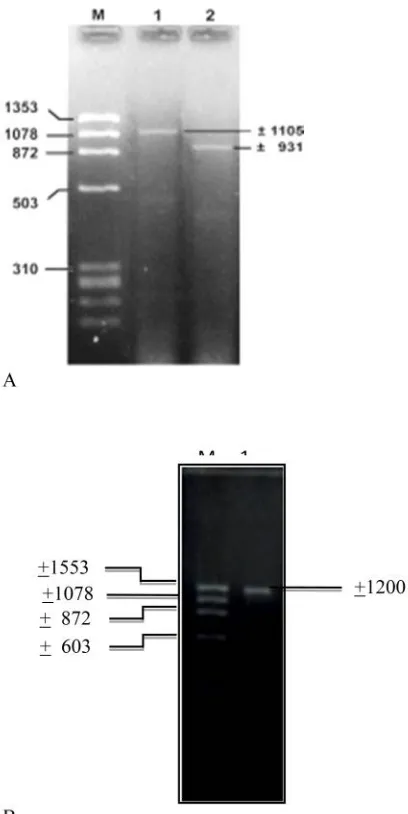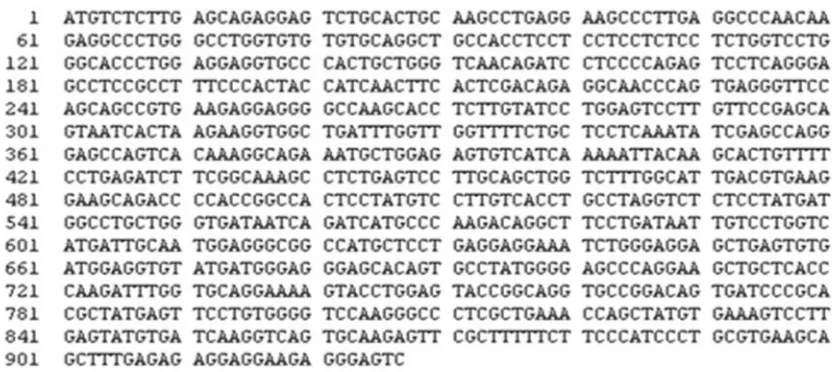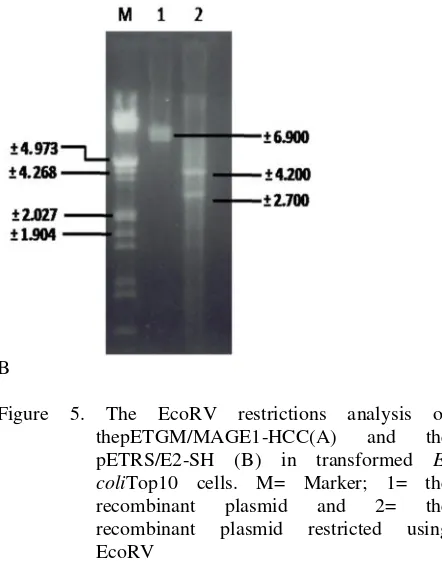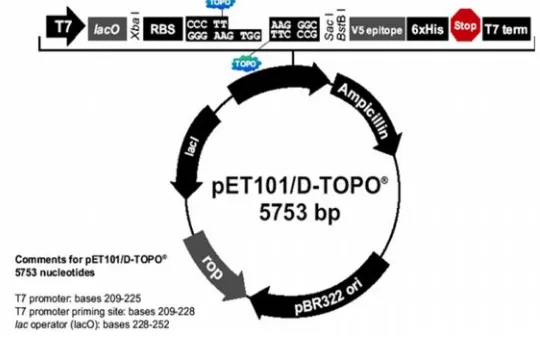DIRECT CLONING OF MELANOMA ANTIGEN 1 (MAGE-1) AND THE E2 GENE OF HOG
CHOLERA VIRUS (HCV) FROM THE BLUNT END PCR PRODUCT USING pET 101/D-TOPO
Gondo Mastutik1, Rosmelati Situmeang2 1
Department of Anatomic Pathology, Faculty of Medicine, Airlangga University 2
Technical Services Unit Area, Veterinary Public Health Laboratory, East Kalimantan
ABSTRAK
Tujuan dari penelitian ini adalah untuk mengkloningkan seluruh area koding gen Mage-1 dan gen E2 Virus Hog Cholera (VHC) menggunakan plasmid pET 101/D-TOPO dan untuk mendapatkan plasmid rekombinan Mage-1dan E2. Sampel diperoleh dari jaringan liver penderita karsinoma hepatoseluler dan jaringan limfa babi yang terinfeksi VHC dari Sukoharjo Jawa Tengah. cDNA diamplifikasi dengan Polymerase Chain Reaction (PCR) menggunakan primer GMTOPOF-GMTOPOR untuk gen Mage-1 dan RS-1-RS-2 untuk gen E2 VHC. Produk PCR yang telah dipurifikasi dikloningkan ke pET101/D-TOPO sebagai vektor ekspresi dengan cara kloning langsung. Plasmid rekombinan yang mengandung gen target ditransformasikan ke E. coli Top10. Analisis plasmid rekombinan dilakukan dengan sekuensing dan analisis enzim restriksi. PCR gen Mage-1 menghasilkan produk +1105pb untuk first round dan +931pb untuk second round. PCR gen E2 menghasilkan produk + 1200 bp. DNA target dikloningkan ke pET101/D-TOPO dari produk PCR dengan ujung tumpul secara langsung. Sekuen seluruh are koding gen Mage-1 mengandung 927 nukleotida yang mengkode 309 asam amino. Sekuen seluruh area koding gen E2 VHC mengkode 1218 nukleotida. Enzim EcoRV memotong vektor pET101/D-TOPO pada nukleotida posisi 545 dan 4775 bp. Hasil dari restriksi EcoRV yaitu pita dengan panjang 4230 pb dan 2450 pb untuk plasmid rekombinan pETGM/MAGE1-HCC dan 4200 pb dan 2700 pb untuk pETRS/E2-SH. Plasmid rekombinan pETGM/MAGE1-HCC dan pETRS/E2-SH telah diperoleh dari produk PCR dengan ujung tumpul secara langsung menggunakan plasmid pET101/D-TOPO.(FMI 2013;49:101-108)
Kata Kunci:kloning langsung, gen Mage-1, gen E2 Virus Hog Cholera, pET101/D-TOPO
ABSTRACT
The objective of this study was to clone the full length of coding region of Mage-1 and E2 gene of Hog Cholera Virus (HCV) using the plasmid pET101/D-TOPO to get the corresponding recombinant plasmid. Samples were obtained from the liver tissue with hepatocellular carcinoma and a pig spleen infected by HCV from Sukoharjo Middle Java. cDNA were amplified by PCR using GMTOPOF-GMTOPOR for Mage-1 and RS-1-RS-2 for E2 HCV.The purified PCR products were cloned into pET101/D-TOPO as direct cloning expression vector. The gene target was transformed into E. coli Top10. Analysis of the recombinant plasmid was undertaken by sequencing and restriction test. The PCR of Mage-1 gene resulted fragments at + 1105bp for first round PCR and at + 931bp for the second round. The PCR of E2 gene HCV produced fragment at + 1200 bp. The DNA targets were cloned into pET101/D-TOPO from the blunt end PCR product directly. The sequence of full length of coding region of Mage-1 contained 927 nucleotides that encoded 309 amino acids residues. The sequence of the full length coding region of E2 gene HCV was encoded by 1218 nucleotide. EcoRV enzyme cuts vector pET101/D-TOPO at nucleotide positions at 545 and 4775bp. The result of EcoRV restriction had band at 4230 and 2450 for pETGM/MAGE1-HCC and 4200 and 2700bp for pETRS/E2-SH. The recombinant plasmid pETGM/MAGE1-HCC and pETRS/E2-SH were obtained from the blunt end PCR product for direct cloning using pET101/D-TOPO.
(FMI 2013;49:101-108)
Keywords:direct cloning, Mage-1, E2 Hog Cholera Virus, pET101/D-TOPO
Correspondence:Gondo Mastutik, Department of Anatomic Pathology, Faculty of Medicine, Airlangga University, Jl. Prof Dr Moestopo 47, Surabaya 60131, phone 62-31-5020251 ext 151, mobile 081231071818, e-mail:
gondomastutik@gmail.com
INTRODUCTION
The gene cloning is an isolation of the target DNA inserted into vector to form the recombinant DNA molecules (Casali & Preston 2003). At the most cases, cloning of the Polymerase Chain Reaction (PCR) product into a circular vector require restriction site extension terminal ends of the DNA target. The
There is a new type of cloning from a blunt end PCR product directly without addition of the restriction sites and digestion by restriction enzymes. The cloning can be done easily and quickly. It only takes five minutes at room temperature, unlike the conventional cloning into the circular plasmid that takes two hours at 16oC. The direct cloning uses an linear vector that is ready for cloning the DNA target and expressing its encode protein. This vector plasmid is pET101/D-TOPO. The plasmid has a size of 5753 bp and is available in a linear form, so that the insertion process can be done directly (direct cloning) without using any form of restriction enzymes as in the case of using a circular plasmid.
Vector pET101/D-TOPO is designed for facilitating a direct cloning of a blunt-end product PCR and over expressing in E. coli. Vector pET101/D-TOPO has T7 promoter to control the gene target expression by induction with isopropyl β-D-1-thiogalactopyranoside (IPTG). T7 lac promotor has a lac operator located at down stream of T7 promotor. Lac operator has a binding site for lac repressor (LacI gene) that serves to suppress T7 RNA polymerase but induces basal transcription of the target gene in E. coli BL21 star. VectorpET101/D-TOPO has the size of 5753bp and is available in a linear form, so that a direct insertion process can be performed (direct cloning) without restricting plasmid such as on a circular (Invitrogen 2006). The cloning is very simple. Typically mixture of 1l of the cloning buffer, 1,5l of the PCR product, and 0,5l. Vector incubated on ice for 5minutes and then immediately transformed into E. coli Top10. It is very simple for cloning.
The DNA target was purified from the PCR product and cloned into the pET101/D-TOPO as direct cloning expression vector. The produced recombinant plasmid was transformed into E. coli Top10. Analyze of the recombinant plasmid was undertaken by sequencing and restriction test. This study was a laboratory explorative study intended to clone the coding sequence of Mage-1 and E2 Hog Cholera Virus using pET101/D-TOPO and to get the recombinant plasmid of the gene target.
MATERIALS AND METHOD
Collecting sampel
Samples were obtained from liver tissue with hepatocellular carcinoma by fine needle aspiration biopsy (FNAB) and a pig spleen infected by Hog Cholera Virus (HCV), an RNA virus. mRNA of Mage-1 was isolated as previously report (Mastutik et al 2010). E2 gene of Hog Cholera virus was collected from a pig spleen infected by HCV when disease out break in 1995
at Sukoharjo of Middle Java. The spleen was crushed and made 10% suspension for virus identification and isolation its RNA by Reverse Transcription Polymerase Chain Reaction (RT PCR).
Amplification of Full Lenght Coding Sequence of Mage 1 and E2 Gene Hog Cholera Virus
cDNA were amplified using a primer pair of
RS-2 (reverse) 5’-ACCAGCGGCGAGTTGTTCTG-3’, producing 1200bp for E2 HCV. CACC sequence was added to the5'-end of the forward primers for sticking on the pET101/D-TOPO cloning site. The reverse primers were designed to be attached to the second last codon before the stop codon TGA as the vector stop codon to facilitate the purification of the expressed protein. The PCR product was electrophoresized with 2% electrophoresis gel and visualized with UV transilluminator. The PCR products were then purified for cloning preparation.
Direct Cloning of the Full Lenght Coding Sequence of Mage-1 and E2 Gene Hog Cholera Virus into plasmid pET101/D-TOPO
The PCR products were cloned into the expression vector pET101/D-TOPO that has a histidine tag marker to facilitate the purification of the expressed recombinant proteins. The cloning reaction consisted of 1l of the cloning buffer, 1,5l of the PCR product, and 0,5l vector. The reaction mixture was homogenized by gently. Incubatedon ice for 5minutes and then immediately transformed into E. coliTop10 for the characterizing of the DNA target.
Preparation of competentcellsE. coliTop10
Top10 competent cells are ready for a plasmid transformation.
Tranformation of the DNA Target intoE. coliTop10
In a 1,5ml microcentrifuge tube, an aliquot of the ligationmix (3l) was mixed with 200l ofE. coliTop10 competent cells carefully and equilibrated on ice for 30minutes. The tube was transferred to a 42oC water bath for 45seconds for heat shocking and then on ice for 5minutes at which 100l of the room temperature of SOC medium was added. The mixture was incubated for 60 min at 37oC temperature water bath and 25l, 50l and 75l of the mixture were grown on solid LB media containing 100g/ml ampicillin at 37oCfor 16 hours. Negative controls were carried out using the same protocols by replacingE. coliTop10 cells with the strile water.
Plasmid Isolation
Transformant cells containing the DNA target were grown in10 ml of liquid LB medium containing ampicillin 100mg/ml by shaking at 200 rpm in a 37oC incubator for overnight and harvested by centrifugation. The recombinant plasmid was isolated from the cells pellet by a protocol from High Speed Plasmid Mini Kit (Geneaid).
Analyze of recombinant plasmid pETGM/MAGE1-HCC and pETRS/E2-SH
The recombinant plasmid was analyzed by sequencing to find the nucleotide sequence of target DNA with Genetic Sequenzer (ABI Prism 310) and by restriction test to find cloning accomplishment. The restriction test was performed using EcoRV enzyme that restricts pET101/D-TOPO at nucleotide positions at 545and4775 bp. The result of the restriction experiment was run on 1% gel electrophoresis. The length of the empty pET101/D-TOPO was 5753 bp. The final result was a plasmid recombinant of the target gene.
RESULT
Amplification of the full lenght coding sequence of Mage-1 and E2 gene Hog Cholera Virus
The mRNA of Mage-1 gene was isolated using RT PCR. cDNA was amplified with a primer pair of GMTOPOF (forward) 5’-CACCATGTCTCTTGAGCA GAGG AGTC-3’ and GMTOPOR (reverse) 5’GCT TTGAGAGAGGAGGAAGAGGGAGTC-3’, producing 931bp. The result of this study was band at + 1105bp for the first round PCR and at + 931bp for the second round
PCR (Figure 1). The full length E2 gene of HCV was isolated using RT PCR. cDNA was amplified with a primer pair of RS-1(forward) 5’-CACCATGGCAT CAACCACGGCATTCCT-3’ and RS-2 (reverse) 5’ -ACCAGCGGCGAGTTGTTCTG-3’. The result of this study was a band at + 1200 bp (Figure 1).
A
B
Direct Cloning of the Full Length Coding Sequence of Mage-1 and E2 Gene Hog Cholera Virus into Plasmid pET101/D-TOPO and Transformation into
E. coliTop10
The DNA targets in this study were cloned into the vector pET101/D-TOPO and transformed into E. coliTop10 to confirm the accomplishment of the cloning, then cultured in LB medium containing ampicillin (100 g/ml). E. coliTop10 is sensitive to ampicilin while pET101/D-TOPO was designed with resistance gene for ampicillin so that only colonies containing recombinant plasmid that can grow on the medium. The transformant cellE. coliTop10 containing recombinant plasmid pETGM/MAGE1-HCC and pETRS/E2-SH (Figure2).
A
B
Figure 2. The plasmid recombinant in transformed cell E. coliTop10. A. pETGM/ MAGE1-HCC (Mastutik et al. 2010); B. pETRS/E2-SH
Analyze of recombinant plasmid pETGM/MAGE1-HCC and pETRS/E2-SH
Analysis of the recombinant plasmids pETGM/MAGE1-HCC and pETRS/E2-SH were performed using Genetic Sequenzer (ABI Prism 310) and by restriction test using a restriction enzyme to determine the cloning accomplishment. The full length sequence of the coding region of Mage-1 is shown at Figure 3. It contains 927 nucleotides that encoded 309 amino acids residues. The full length sequence of the coding region of E2 gene of HCV isolate Sukoharjo consists of 1218 nucleotide (Figure 4).
Figure 4. Sequence of the full length of coding region of E2 gene of HCV.
Restriction experiments were performed using EcoRV enzyme that restricts pET101/D-TOPO at nucleotide positions at 545 and 4775 bp. The fragments produced by the experiments were run on 1% gel agarose elctroforesis that produced two bands. Length of the empty pET101/D-TOPO is 5753 bp. The final result was a plasmid recombinant of the gene target. The results of EcoRV restriction show two bands at 4230 and 2450 bp for the pETGM/MAGE1-HCC and at 4.200 and 2.700 bp for the pETRS/E2-SH (Figure 5). The map of the recombinant plasmids pETGM/MAGE1-HCC and pETRS/E2-SH are shown at Figure 6.
A
B
A
The objective of this study was to clone the full length coding region of Mage- 1 and E2 gene of HCV using pET101/D-TOPO and to get the corresponding recombinant plasmids. Mage-1 is a human gene which contains exon and intron. To express its protein, the gene should be isolated from the mRNA of Mage-1 to avoid the intron splicing during mRNA synthesis. The mRNA of Mage-1 was reverse transcribed to its cDNA, amplified by PCR, and cloned into an expression vector.
HCV was an RNA virus which causes diarrhea previously at a pig. The envelope site of the virus can induce immune response host without making infection. The envelope site can be used as vaccine to induce the immune response. Isolation of the full length of E2 gene was done to get the recombinant plasmid pETRS/E2-SH as candidate for vaccine Hog Cholera infection. Samples were obtained from a liver tissue with hepatocellular carcinoma and a pig spleen infected by HCV isolated fromSukoharjo, Central Java. cDNA were amplified with GMTOPOF (forward) and GMTOPOR (reverse) for Mage-1 and a primer pair of RS-1(forward)
and RS-2 (reverse)for E2 Hog Cholera Virus. The blunt end of the PCR products was cloned into the pET101/D-TOPO as direct cloning expression vector.
An ideal plasmid for cloning vector should have the properties include 1) self-replicatinga utonomously in bacterial cells, 2) having one or more marker(s), e.g. antibiotics resistance marker, 3) has some sites for the restriction enzymes, 4) plasmid is not transmissible and mobilisable, 5) is smaller plasmid size (<10kb) for efficiency transformation because the transformation efficiency will decrease with increasing size of the plasmid, and 6) has multi copy plasmids percell (Puspaningsih 1999). Vector pET101/D-TOPO has all the requirements. It is designed for facilitating a direct cloning of a blunt-end PCR product that can be overexpressed in E. coli. The vector pET101/D-TOPO has the size5753bp and are available in the linear form, so that the process of insertions directly can be performed (direct cloning) without first doing restriction experiment such as in common case for a circular plasmid (Invitrogen 2006).
The pET101/D-TOPO plasmid is designed with GTGG overhang for attaching the PCR products that have CACC at its 5'-end that is complementary to GTGG. The GTGG overhang is generated due to the work of the enzyme topoisomerase Iwhich derived from Vaccinia virus. This enzyme binds to duplex DNA at a specific site and cuts the phosphodiester back bone after 5'-CCCTC on one strand of DNA TOPO vector (Invitrogen 2006). The map of the pET101/D-TOPO is shown at Figure 7.
Vector pET101/D-TOPO has T7 promoter to control the gene target expression by induction with IPTG. T7lac promotor has a lac operator located at down stream of T7 promotor. Lac operator has a binding site for lac repressor (Lac I gene) that serves to suppress T7 RNA polymerase induces basal transcription of target gene in E. coliBL21 star.
Figure 7. The map of pET101/D-TOPO (Invitrogen 2006)
Direct Cloning of the Full Length Coding Sequence of Mage-1 and E2 Gene Hog Cholera Virus into plasmid pET101/D-TOPO and Transformation intoE. coliTop10 The purified of PCR product was cloned to the expression vector pET101/D-TOPO directly from the blunt end PCR product without restriction enzyme treatment because this vector is already designed for a direct cloning. The PCR product was purified then inserted into vector, pET101/D-TOPO and transformed into E. coliTop10 to confirm the accomplishment of insertion.E. coliTop10 cells were grown on the LB agar plate medium containing ampicillin for selection. The results are shown at Figure 2.
E. coliTop10 was prepared as competent cells to accept plasmid by adding CaCl2 to transformE. coliTop10 in preparation. The function of CaCl2 is to weaken the cell wall ofE. colithat facilitates the recombinant plasmid migrates across the cells during the heat shock (Puspaningsih 1999). E. coli that is ready for use is called transformation competent cells. The DNA target in this study was cloned to the vector pET101/D-TOPO and transformed intoE. coliTop10. The cells were then cultured in LB medium containing ampicillin (100 ug/ml). E. coliTop10 is sensitive to ampicilin and pET101/D-TOPO is designed with resistance gene for ampicilin so that only colonies which contain the recombinant plasmid can grow on the medium. Selection of the tranformant cells was done by selecting
antibiotic and selecting white and blue colonies. Transformant cells were grown on LB medium containing ampicilin. E. coliis sensitive to ampicillin, while the plasmid are resistant to ampicillin so that only theE. colicontaining the plasmid is able to grow on that medium. E. coli for cloning direction was designed to have X-gal. The plasmids have Lac Z gene that synthesize galactosidase. Galactosidase has the ability to hydrolyze X-gal and changes the colonies color to blue. The multiple cloning site is located in the area of Lac Z gene, while the target DNA fragments is inserted in the lac Z gene area. Because of that Lac Z gene cannot synthesize galactosidase so that X-gal is not hydrolyzed. The result is the white colonies, so E. coliTop10 colonies containing the recombinant plasmid are the white colonies (Sambrook & Russell 2001). The white colonies are shown at Figure 2.
Analysis of the recombinant plasmid was undertaken by sequencing and by restriction test. Sequencing of the recombinant plasmid pETGM/MAGE1-HCC and pETRS/E2-SH was performed using Genetic Sequenzer. The sequence is shown at Figure 4. The Bioinformatic analysis shown that EcoRV does not cut the coding sequence of MAGE-1 and E2 genes. EcoRV cuts in two sites at nucleotide position 545 and 4775 on the restriction that the blunt end GATATC site on TA.
Length of the empty pET101/D-TOPO is 5753 bp. Electrophoresis of the restriction results performed on 1% agarose gel containing ethidium bromide and then visualized with UV transilluminator. The result is shown at Figure 5. The final result was a plasmid recombinant of the gene target. The result of EcoRV restriction show band at +4230 and +2450 bp for pETGM/MAGE1-HCC and a +4200 and +2700 bp for pETRS/E2-SH. The final result of this study was to get the recombinant plasmid pETGM/MAGE1-HCC and pETRS/E2-SH that are shown at Figure 6.
CONCLUSION
The recombinant plasmid pETGM/MAGE1-HCC and pETRS/E2-SH were obtained form the blunt end PCR products by direct cloning using the plasmid pET101/D-TOPO.
ACKNOWLEDGMENT
REFERENCES
Casali N and Preston A (2003). E. coli Plasmid Vectors: Methods and Applications, Totowa, Humana Press, p 54-78
Invitrogen (2006). Champion pET Directional TOPO expression Kits Version II Manual Part No 25-0400, User Manual
Mastutik G, Hardjowijoto S, Lunardi JH, Puspaningsih NNT, Soetjipto, Kusumobroto HO, Putra ST (2008). Molecular analysis of the coding sequence of mage-1 gene fromhepatocelular carcinoma patient and testis. Folia Medica Indonesiana 44, 224-232
Mastutik G, I’tishom R, Lunardi JH, Puspaningsih NNT, Soetjipto, Kusumobroto HO, Putra ST (2010). Cloning of melanoma antigen-1 (mage-1) gene from
fine needle aspirationbiopsy of hepatic tissue of hepatocelluler carcinoma patients. Folia Medica Indonesiana 46, 200-205
Puspaningsih NNT (1999). Pembentukan sel R.hQ (Saccharomyces cerevisiae) galur baru yang mampu mencerna pati secara langsung menjadi etanol melalui kloning gen amilase. Research Report. Universitas Airlangga, Surabaya
Sambrook JF and Russell DW (2001). Molecular Cloning: A Laboratory Manual, 3rd ed., New York, Cold Spring Harbor Laboratory Press




